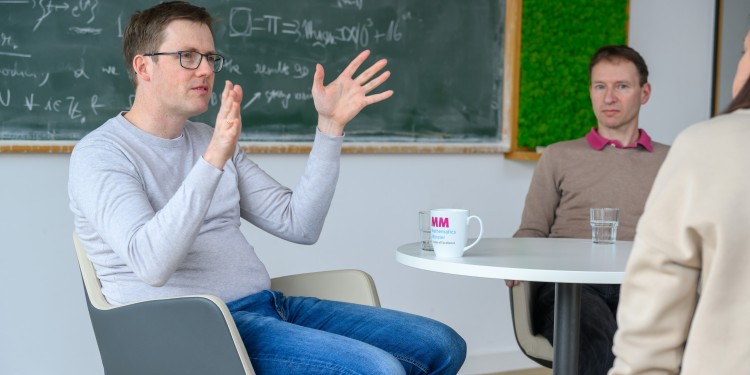
“Learning from one another means we arrive at findings faster”
Excellent research is not possible without interdisciplinary working. But, even within one discipline, collaborations crossing the barriers between research areas can lead to new approaches and findings. Mathematics is an example of this. Prof. Hendrik Weber, who heads the Stochastic Analysis working group, and Prof. Raimar Wulkenhaar, who leads the Mathematical Physics working group, work together within the framework of the Cluster of Excellence “Mathematics Münster”. In this interview with Kathrin Nolte, the two mathematicians talk about the opportunities which exchanging ideas presents, as well as the challenges they face.
The non-specialist assumes that all mathematicians can discuss what their research is about and, in doing so, understand what the others are working on. Why is this not always the case?
Hendrik Weber: Mathematics is a big subject which has existed for a long time and which has spread out in many very different directions. For that reason, it doesn’t surprise me that the various branches which exist differ as far as their content is concerned.
Raimar Wulkenhaar: And it always depends on the level we’re talking about. In a talk given in a colloquium, we certainly understand what’s being spoken about. But that doesn’t mean that you can work in that field. For that, much more is required because we’re all specialists in our respective fields of research.
What are the opportunities offered by networking different branches of mathematics?
Raimar Wulkenhaar: We create new tools or use existing ones if we want to solve mathematical questions and problems. But because there are very many tools, such as models and theories, we don’t know them all. Networking within our discipline involves sharing these tools. That’s why we discuss with one another.
Hendrik Weber: Our collaboration, specifically, involves analysing models from quantum field theory. Quantum field theory actually comes from theoretical physics. It was originally developed in order to understand matter such as elementary particles on the smallest scales. For more than 70 years now, physicists have been working successfully with this theory. Mathematicians, on the other hand, are not satisfied with the quantum field theory because they want to have a deeper understanding of things from the mathematical standpoint. While I work on stochastic analysis, Raimar deals with mathematical physics. Over the past few years there have been some special breakthroughs in stochastic analysis – some of them unexpected – which enable us to take entirely new approaches to problems in quantum field theory. It was for this reason that we joined forces.
That sounds as if there are a few challenges waiting for you …
Raimar Wulkenhaar: Yes, that’s right. The challenge of quantum field theory is in understanding the four dimensions of the world: length, breadth, height and time. While we already have a good understanding of length, breadth and height, time is a more difficult matter. The question now is whether what we already know about the three dimensions is enough to understand the fourth – or whether we need more methods for that. Hendrik and I want to change the rules that have applied so far. Step by step, we’re feeling our way towards bringing together quantum field theory and new methods of stochastic analysis. That hasn’t been done so far in research.
What exactly is your collaboration like in your everyday work?
Hendrik Weber: For one thing, we’re jointly supervising a PhD student. As a result, we’re practically obliged to keep in contact. For another, we already held a joint seminar in the winter semester of 2022/23 so that each of us could gain an overview of what the other had in his “toolbox”. Also, we are currently organising a workshop for the subject communities in our fields of research.
Is it difficult to look at a research problem together from different angles?
Hendrik Weber: No. When we discuss together, it’s much easier to solve a problem than if each tries to sift through the research literature himself. In the specialised branches of mathematics, specialist vocabulary is often introduced which each of us only understands for his own field. In the literature I often read about “melonic” graphs, for example, and had no idea what was meant. I learnt from Raimar that the graphs have that name because they look like melons. That’s just one example of many which makes it clear that mutual understanding is fundamental if we want to understand the various branches of mathematics. Learning from one another means we arrive at findings faster.
What are the opportunities and the risks presented by your collaboration?
Raimar Wulkenhaar: If we already knew how everything functions, we wouldn’t need to work together. Our everyday work as researchers is characterised by the fact that we don’t know whether we’ll find a solution that works. The uncertainty is a constant risk which is always with us. The opportunities for us lie in the fact that we can solve mathematical problems through adopting new perspectives and extending the methods used so far.
The Cluster of Excellence
In the Cluster of Excellence “Mathematics Münster: Dynamics – Geometry – Structure”, around 190 researchers tackle mathematical questions of fundamental importance – for scientific, economic and technological progress. The research alliance, which has been receiving funding from the German Research Foundation since 2019, has the aim of combining various branches of mathematics and, as a result, developing new research methods.
